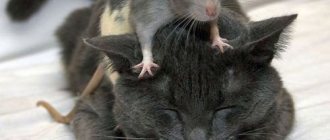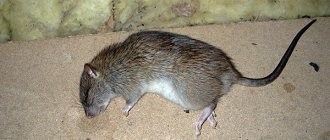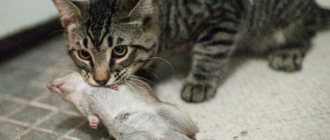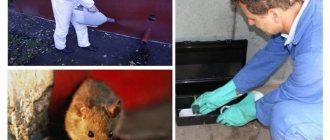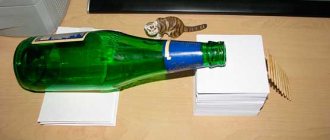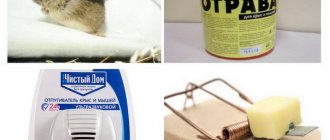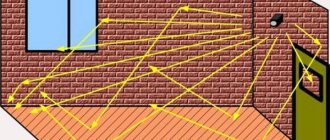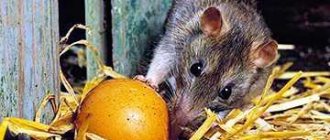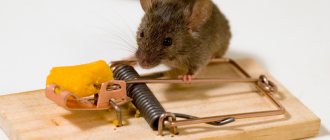Rodents are a real scourge of private homes. As a rule, they become active in the fall. It gets cold in the basement and attic, so they move into the living space.
Few people like this kind of neighborhood. Rats and mice are not just obsessive rustling and fussing at night, but also sources of infection. It is known that the most dangerous diseases were transmitted to humans precisely from rodents (mice, including bats, rats, etc.). These diseases are transmitted to people and pets. The issue is especially relevant for dog breeders - dogs are easier than cats to become infected with infections carried by rodents.
These creatures cause disgust and disgust in almost all people. How to get rid of rodents in a private home? We share proven effective methods.
Method 1. Mouse or rat trap
Mouse in a mousetrap.
We are talking about a mousetrap - a device that everyone has probably heard of (and some have seen in person). This is a kind of trap for rodents. For rats, by the way, they use rat traps - a reinforced version of a mousetrap with a stronger spring and sharp teeth on the base.
There are different types of traps: mechanical, in the form of “jaws”, etc. There are many options, but the method of action is almost the same.
The technology is simple: you put bait, for example, a piece of lard or cheese, into the trap and “load” the mousetrap, that is, cock the trigger. A mouse or rat comes to the smell and tries to steal the bait. At this moment the mechanism is triggered and the trap slams shut. If the mousetrap is mechanical, then a metal bracket is forcefully lowered onto the mouse’s neck. If the mousetrap is shaped like “jaws,” they slam shut and break the rodent’s neck. If the device is electric, a rodent caught in it will receive an electric shock.
This is an effective way to get rid of mice and rats. It is effective, but not the most humane. Although if we are talking about fighting rats and mice, then here, as in war, any methods are good.
Pros : inexpensive, effective, time-tested.
Cons : this method is good if there are a couple of mice or rats running around the house. If a whole flock of them is not suitable, a more global solution is needed.
Not suitable for squeamish and impressionable people - you are unlikely to be inspired by the prospect of pulling a dead rodent out of a trap.
Be careful if there are children, cats or dogs at home. If they are attracted by the bait, they may get caught in the trap themselves.
Cat and mousetrap.
What smells repel mice
A good and safe way to keep your area and home free of mice is to use repellent scents. For the most part, they are safe, easy to use, and affordable.
Plants and herbs
Plants that can affect animals include:
- sagebrush;
- peppermint;
- hazel grouse bulbs;
- coriander;
- chamomile;
- daffodils;
- pyrethrum;
- tansy;
- Solanaceae;
- lavender;
- heather;
- chrysanthemums.
These herbs are absolutely harmless to both humans and animals.
Poisonous herbs
The use of poisonous and toxic plants has a good effect. However, they can only be stored in places where children and pets cannot reach. These herbs include:
- wild rosemary;
- elderberry;
- blackroot.
Possible disadvantages of the method
Aromatherapy is considered the cheapest and most humane way. But there are certain nuances:
- habituation of rodents to odors, alternation is recommended;
Rodents have a good sense of smell.
- the smell of dry herbs is more persistent in tightly tied clean linen bags;
- You should not give preference to freshly cut plants, as they quickly lose their aroma;
- It is best to use several scents at the same time;
- It is prohibited to use allergenic plants.
How to use plants and herbs
It is worth noting that proper handling of herbal raw materials will ensure maximum results.
- Leaves and stems are placed on the floor and in the corners of rooms.
- Dry grass is placed in bags.
- It can be divided into several small bunches and dipped in boiling water to enhance the aroma.
- It is also recommended to fumigate the rooms.
- You can place plants that are unpleasant for rodents in flowerpots or pots on windows, although their effect is short-lived.
Many aesthetes believe that this spoils the interior of the room. In this case, preference is given to essential oils and extracts. Their concentrated aroma greatly deters pests. Cotton pads are soaked in the product and placed in doorways. Replace with fresh ones periodically.
Are you afraid of mice?
Very Not a drop
Method 2. Glue board
Glue board.
This budget-friendly method will also help get rid of rats and mice. You smear glue on a piece of wood - essentially, it turns out to be the same mousetrap, only not a mechanical one. You can buy a ready-made glue board. Place bait on it. The rodent comes to the smell and sticks to the board. All you have to do is throw away the board and the rat or mouse.
Pros : very budget method. In addition, you won’t get your hands dirty - you can simply throw away the board with the rodent without even touching the mouse or rat.
Cons : this method is quite cruel. Are you ready to listen to the heart-rending squeak of a rodent that has stuck its paws and fur to the board?
Why are rats and mice dangerous?
Such rodents, despite their small size, can cause a lot of harm to humans. Mice spoil and gnaw things around them and attack people. There are bacteria in their mouths.
The danger lies in the fact that rodents carry the following diseases:
- plague;
- Weil's disease;
- typhoid and salmonella.
A person can become infected with illnesses through foods that a mouse has already tasted, or that a rat has run over. In addition, rodents leave physiological waste everywhere, containing various bacteria and viruses. Their vapors pollute the air and cause health problems. Those who have weakened immune systems are especially at risk.
Method 3. Live trap
Mouse in a cage.
It looks like a mousetrap, but it works differently - the rodents remain alive.
You need to put bait inside the cage and install the trigger. When a rodent enters the cage and tries to eat, the mechanism will work and the door will slam shut. Rats or mice will be trapped inside. All you have to do is take them away from home and release them into the wild.
When shaking a rodent out of a container or cage, be careful. Do not touch a mouse or rat with your hands - they may bite or scratch you and transmit an infection.
Pros : More humane than a regular mousetrap. You will be able to empty devices without disgust or disgust. It is more pleasant to release a rat or mouse than to remove the remains from the device.
Cons : effective if there are a couple of mice living at home. A live trap is useless against a flock.
Causes of mice
There are several reasons why rodents visit your home:
- Food. If the food in the house is in easily accessible places, packaged in bags, the cupboard with cereals is located less than 1.5 meters from the floor, pests will like this place of residence.
- Warm. Like any other pests, rodents love warmth. As soon as it gets cool outside, mice begin to look for a place to hibernate. These are our houses and apartments.
- Mess. Another important factor that causes pests to visit your home is poor sanitation. If food scraps are regularly left on your counters and your trash can is always overflowing, this means there will be plenty for mice to eat at night.
Method 4. Specialized poisons
A mouse poisoned by poisonous bait.
Pesticides are used if there are more than 10 rodents living at home. This is a proven way to get rid of mice and rats in the house for a long time.
There are different poisons. Some act instantly, others accumulate in the rodent’s body and it does not die immediately.
The scheme is simple: you place poison where mice and rats walk. Be sure to follow safety precautions - use gloves when placing poisonous baits, do not touch your face, and wash your hands thoroughly. Sometimes it is recommended to wear a respirator, but this depends on the specific substance.
Rodents eat the poison along with regular food and die.
Remember : first, mice and rats need to be fed regular food for a couple of weeks. And only when they get used to it, add poison to the food. Then they won't notice the catch.
If you have children or pets, place the poison in special containers. Rats and mice will get through there, but household members, cats and dogs will not be able to get the poisonous bait.
Container with poison.
Pros : effective if there are hordes of rats or mice running around the house. Allows you to get rid of mice and rats in a private home forever or for a long time.
Cons : if there are small children or animals at home, place the poison only in containers. One more thing: if a rat or mouse dies while hiding in your home, a disgusting smell will appear. And eliminating its source will not be easy.
Prevention of rats
Unfortunately, simply keeping the house tidy and clean is not always enough. To protect your home from rodents, try attaching a fine grille to all ventilation ducts, and also seal all the cracks and seal the water supply system. It is best to store food in containers with tight lids, and dispose of garbage as quickly as possible so that pests do not have access to food.
You can take action already at the stage of laying the foundation of your private house or cottage - install a fine-mesh mesh vertically in the cement and seal all small holes.
If you live in an apartment, remember that many of the listed herbal products can be grown even on the balcony and used both to scent the room and to repel rats.
Method 5. Homemade gypsum-based poison
A rat that ate poison.
Folk remedies for mice and rats include homemade poisons.
The main components are gypsum (alabaster) and flour. You can make balls out of them or just pour them into a bowl. Be sure to have water nearby. The rodents will think they have found a tasty meal and will eat the bait. Then they will drink water. Plaster of Paris that gets into the stomach of a rat or mouse will harden and cause intestinal obstruction. Because of this, the rodent will die. After this, you will have to inspect the house for dead rats and mice.
Life hack : you can make a poison, after which the dead rodent will not decompose, but will dry out, that is, mummify. Broad-spectrum antibiotics must be added to it. Their operating principle is as follows: a rat or mouse will die from the poison, and antibiotics will destroy bacteria that appear during the decomposition process. There will be no bacteria - there will be no smell. True, such antibiotics are quite expensive.
Pros : suitable for mass extermination of rats and mice. Not poisonous.
Cons : if you add antibiotics, the poison will be expensive.
Lures
This folk method of fighting rodents at home involves the use of poison for mice. It is recommended to use it only in case of mass reproduction of pests or when all other methods have proven useless.
To make poison for mice, you can use the following recipes:
- Mix 200 g of grain, 200 g of sugar, 500 g of gypsum and 60 ml of sunflower oil. Based on these components, prepare a homogeneous mass and spread it near rodent burrows. Mice, attracted by the smell of the grain bait, consume it. Subsequently, the mass in the stomach hardens, which leads to blockage of the digestive system and the death of the rodent.
- Mix equal amounts of soda, starch and sugar. Place bait near the rodent habitat. When the pests eat the mixture, a toxic gas is released in the stomach, causing intoxication.
- You can prepare poisoned grain by mixing it with putty in equal quantities. The resulting composition should be poured onto paper and placed near the mice holes, and containers with water should be placed nearby.
Method 6. Ultrasound
Ultrasonic rodent repeller.
An ultrasonic repeller is a device that helps get rid of mice and rats in a private home. A person does not hear the ultrasound that the repeller emits, but rodents react to it. It causes them to panic, so rats and mice rush to leave the house and get away from the irritant.
How to get rid of rodents using ultrasound? Install repellers on the floor, in the basement, in the attic - so that the sound wave does not encounter obstacles. It must be located in an open space.
Pros : perhaps this is the most effective and modern way to get rid of mice and rats in the house. It is environmentally friendly, humane, safe for households and pets.
Cons : over time, rodents may get used to ultrasound and stop responding to it. This means you will have to look for another way to deal with them.
This method is not suitable if you have decorative mice or rats - ultrasound will also affect them. Animals will become restless and nervous.
How to get rid of mice in the country in winter
With the onset of cold weather, when rodents enter homes en masse, it is necessary to take care of safety and take preventive measures in the fall.
- It is not recommended to place compost pits or garbage heaps near your home. Mice most often spend the winter in such places.
- Check the walls, floor and attic for holes from previous rodent visits. Place crushed glass, aromatic herbs, and pesticides in them.
- Ensure that all food supplies and water sources are sealed.
- Lay out traps and install repellers.
When leaving the dacha for the winter, it is necessary to leave the premises and territory without sources of food for mice.
Advice! To protect garden plants, trample the snow around them. This will prevent rodents from getting closer to the bark of trees and shrubs.
It is effective to use liquids with a strong odor. For non-residential premises, formalin, creolin, turpentine and kerosene are used. For owners who are absent from their dacha in winter, this will not cause discomfort and will repel pests. This is especially true in cellars and basements, where mice cause particular harm. The corners should be sprayed and a rag soaked in one of these products should be spread out. You can burn a piece of rubber in a bucket and fumigate the basement. The procedure must be repeated periodically.
Before leaving the dacha for the winter, you should place repellent plants in all rooms and areas, the smell of which mice cannot tolerate. Dried plants are hung in bunches, laid out in bags, and scattered crushed on the floor. Among the most “fragrant”:
- pyrethrum;
- chamomile;
- chrysanthemum;
- lavender;
- mint;
- sagebrush.
They use deadly poisonous plant species that are added to baits to kill rodents:
- dope;
- henbane;
- hemlock.
It is necessary to work with such dangerous crops as carefully as possible, following safety rules. Wear rubber gloves, goggles, a bandage, and protective clothing.
Advice! The smell of mothballs is also not to the taste of pests. It is mixed with sawdust and laid out near burrows, in rodent habitats. This mixture can be pushed directly into holes.
To protect your products in cellars and basements, they are pre-prepared. Broken glass is placed in holes and cracks and concreted. A fine mesh is attached to the ventilation holes, and the room is fumigated using sulfur bombs or other means.
Using all methods and means in a comprehensive manner is a guarantee of getting rid of rodent pests in your dacha forever. It is recommended to periodically visit the site and inspect the premises.
Seasonings and spices
Fragrant herbs and spices are an excellent solution in the fight against rodents. It is absolutely safe for people. Suitable application:
- cilantro or its seed;
- sage;
- carnations;
- red hot pepper.
Field mouse.
First, grind the seasonings into powder and sprinkle on the baseboards. Pests most often appear in these places. Freshly roasted ground coffee has a similar effect. The downside is rapid weathering. Sprinkle sage and fumigate the room.
Vinegar is very effective. It is poured into small containers and placed on the floor. Such manipulations are carried out in non-residential rooms.
Natural flavors
Animals that hunt mice will help solve the problem. You can get a cat. The smell alone will scare the pests and they will leave the room.
If this is not possible, it is possible to simulate the presence of a cat. It is appropriate to use used cat litter. They sprinkle it on the corners and entrances to burrows. They also use rags soaked in cat urine.
Faster results can be achieved by imitating snakes and rats. For the former, mice are food, for the latter, they are competitors in the struggle for food sources. A small amount of snake and rat excrement will repel pests. They are placed in the place where the rodents appeared. You can get excrement at any pet store.
